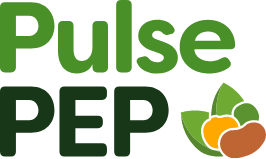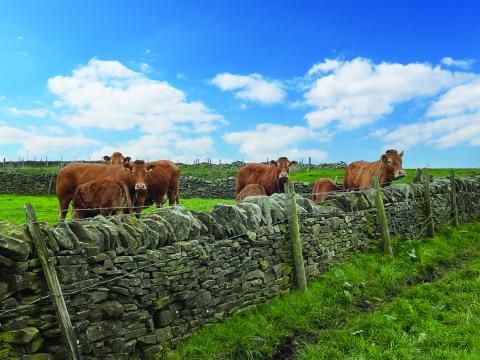Brothers Karl and Richard Suddes have long been focussed on producing home-grown feed on their County Durham family farm. With Richard being an early adopter of regenerative farming practices – and in fact earning the title of Soil Farmer of the Year in 2017 – and Karl keen to produce a high-performance beef ration at the least possible cost, the objectives of the brothers dovetail well.
But with the best of the male and female progeny from the farm’s 120 pedigree Limousins destined for
breeding and many sold through premium bull sales in Carlisle and Darlington, any compromise to performance is not an option.
So, the search has been on for many years, for high-performance, low-cost and ecologically sustainable feeds, with several options tried and tested, and some abandoned along the way. And with the location of South Farm, in the village of Cornsay, some 900 feet above sea level, the search is all the more challenging.
But the brothers have overcome the odds across the 800 acres they farm with their parents, Rob and Janis, and the additional 400 acres they’ve taken on as share farms over the past seven years.
Today, the best of their bull calves hit 100-day weights of 180-220kg, 200-day weights of 330-380kg, and reach sale ring condition at 16-18 months. The success of this strategy is regularly seen in the leading prices achieved, including an average of £4,000 for the three Cornsay bulls taken to Darlington in late May and a £6,000 average for three at Carlisle earlier in the month.
That the bulls’ superb level of finish is achieved with an almost exclusively home-grown ration, with minimal artificial fertiliser or agrochemical inputs, and without the use of soya, is a credit to the determination of the brothers to grow and preserve the best quality and most sustainable feed. This also means the bulls tend to go on to do well in their new homes, having not been pumped full with high protein and high energy concentrates, but instead fed a well-balanced total mixed ration,
supplemented with extra concentrate around six weeks before sale.
The TMR - fed between around 10 to 14 months - includes grass silage, barley, beans, peas and oats, with all grains and pulses grown on the farm and preserved with Propcorn NC. Overall protein in this ration is 15.1% and metabolisable energy is 11.4MJ/kg DM.
This is switched to a concentrate and straw-based diet, with the inclusion of Propcorn NC-treated wheat with extra oats and peas some 6-8 weeks before sale. This lifts ME to 12.2MJ/kg DM and protein to 15.8%.
There’s slight variation for fat bulls not sold for breeding, which are weaned at 10 months and moved on to a high energy finishing ration with the aim of selling from 12-14 months at 600-700kg.
Only in the first four months of life is any purchased feed consumed, in the form of a high palatability calf starter pellet.
Despite the success of the rations today, the brothers still consider them to be a work in progress and have experienced hiccups along the way.
Using a urea preservative for cereals in the calf ration was one such mistake, which has now been remedied following the range of problems this caused.
Karl says: “We rolled and treated the wheat with a urea product at harvest but by spring, it was like a heap of flour on the shed floor. So, next time, we treated the grain whole and then rolled it when needed, but it set in blocks and was difficult to go through the mill.”
But worse than all of this was the loss of crude protein from the urea-treated crop, which was measured at feed-out at three percentage points lower than at the time of harvest.
Michael Carpenter, Technical Director for Kelvin Cave Ltd, who advised the Suddes family on alternative methods of preservation says the loss of crude protein when grain is treated with urea is
well known.
He says: “The urea in the additive is intended to both act as a preservative and increase the non-protein nitrogen and crude protein of the feed. However, around half the urea nitrogen applied to grain – and often even more – is known to be lost to the environment before it reaches the animal’s mouth.
“This is caused by its conversion to ammonia and its dissipation into the air,” he says. “This is a well-known phenomenon which has been consistently reported through independent science but often fails to reach the farming press due to massive vested and advertising interests.”
Ditching urea as a preservative in their rations, the Suddes brothers now find alternative sources of protein by growing more pulses. These have been preserved, just like much of the farm’s cereal crop, using Propcorn NC.
However, crimping was also tried for the first time last year, using the salts-based preservative, CrimpSafe 300. This allows for storage in a clamp, rather than a dry store or shed, required for the Propcorn-NC treated product.
“CrimpSafe 300 works by controlling the fermentation of the crimped grain, minimising the nutritional loss which could occur in a poorly controlled fermentation and maximising protection against spoilage organisms,” says Michael.
“We find the crimp to be pretty good stuff,” says Karl. “It is palatable and soft and the cattle really like it and the bulls fatten well on it, so we’ll be crimping more grain this year.
“Everything now goes through our Korte 1000 mill and is far more palatable than rations we’ve fed in the past, historically often based on dry grain,” he adds.
Always aiming to improve the arable options he supplies to the livestock business, Richard says he is trialling a variety of winter-sown, combinable pea called Fresnel.
“We’ve grown spring peas in the past but been caught out by the frost,” he says. “And we’ve tried winter peas but could only find a forage variety.
But for this season, we drilled this combinable pea in October and the crop looked full of flower in spring. We expect to sell some and keep some for crimping, and if it yields well, we will put more in next year,” he says.
As the brothers reflect on their successes to date, they’re pleased with the outcomes, but always seeking more.
Richard says: “The best regenerative farming you can get is mixed farming with circular systems – that’s what we have.
“We keep cutting back inputs and the crops look just as good – that’s down to direct drilling for 13 years improving soil health and chemistry, with more nutrients feeding healthy plants which suffer from less disease,” he says.
Meanwhile, Karl says he’s happy that 95% of the ration is home-grown, but he’d like to increase this further and match the 18% protein of the calf pellet with comparable home-grown feeds.
“Yes, we’re happy with what we’ve done but there’s always room for improvement,” he says.
Both brothers agree they need to experiment and push boundaries to further progress.
As for profitability, they’re also on the same wavelength. “Yes,” they agree. “Our farming system today is profitable, without a doubt.”
Grain and pulse preservation products used at South Farm
Propcorn NC is used to preserve any grain or pulse at the time of harvest on the Suddes family farm. The product is the non-corrosive version of its well-known predecessor Propcorn and is applied through the Korte 1000 grain roller. Propcorn NC safeguards any whole or processed cereals or pulses against the formation of yeasts, moulds and mycotoxins during storage for up to 12 months, also preventing heating in moist feeds at moisture contents of up to 25%. Treated grain is stored in a dry grain store, bin or bunker and is free-flowing in ad lib hopper systems.
In independent worldwide tests, livestock fed on Propcorn-treated feeds have shown it improves milk
yields by up to 4%, increases liveweight gain in beef cattle by up to 4% and improves feed-conversion
efficiency in pigs by up to 6%.
CrimpSafe 300 was used for the first time on South Farm last year, to preserve moist cereals. Applied at the time of harvest through an applicator on the grain roller, the process preserves grain at its maximum nutrient value and digestibility and achieves maximum dry matter yields per hectare. Crimp is stored in a clamp and sealed in airtight conditions so requires no dry grain storage facilities. The most digestible crimped grain, which achieves the best animal performance, is harvested at moisture
contents of 25-45%. Different crimping products can be used from 15% moisture.
Crimping has numerous advantages including the earlier harvest of a more nutritious crop which achieves outstanding rumen health and animal performance. Farmers also value the agronomic
benefits, including the extra time provided to establish autumn crops.
Using either Propcorn NC or CrimpSafe 300 reduces the cost and environmental impact of livestock feed production by eliminating the need for grain drying and minimising feed transport distances.
Access the original article as it appeared in Kelvin Cave's KnowHow Newsletter in summer 2022 below.



